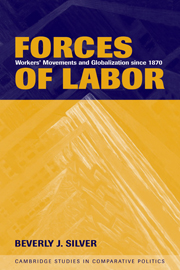Book contents
- Frontmatter
- Contents
- List of Figures
- List of Tables
- Preface and Acknowledgments
- 1 INTRODUCTION
- 2 LABOR MOVEMENTS AND CAPITAL MOBILITY
- 3 LABOR MOVEMENTS AND PRODUCT CYCLES
- 4 LABOR MOVEMENTS AND WORLD POLITICS
- 5 CONTEMPORARY DYNAMICS IN WORLD-HISTORICAL PERSPECTIVE
- Appendix A The World Labor Group Database: Conceptualization, Measurement, and Data Collection Procedures
- Appendix B Instructions for Recording Data from Indexes
- Appendix C Country Classifications
- References
- Index
- Cambridge Studies in Comparative Politics
Appendix B - Instructions for Recording Data from Indexes
Published online by Cambridge University Press: 05 June 2012
- Frontmatter
- Contents
- List of Figures
- List of Tables
- Preface and Acknowledgments
- 1 INTRODUCTION
- 2 LABOR MOVEMENTS AND CAPITAL MOBILITY
- 3 LABOR MOVEMENTS AND PRODUCT CYCLES
- 4 LABOR MOVEMENTS AND WORLD POLITICS
- 5 CONTEMPORARY DYNAMICS IN WORLD-HISTORICAL PERSPECTIVE
- Appendix A The World Labor Group Database: Conceptualization, Measurement, and Data Collection Procedures
- Appendix B Instructions for Recording Data from Indexes
- Appendix C Country Classifications
- References
- Index
- Cambridge Studies in Comparative Politics
Summary
This appendix contains the instructions used by persons recording data from newspaper indexes. Examples of how to classify events, the introductory statement, and the lists of index headings to use as a guide in searching the index are not included here. The latter is a several-pages-long list of industries, countries, and other subject headings.
What Types of Reported Actions to Record
Record any action indicative of labor unrest (see definition).
“Labor” includes wage workers and the unemployed (it does not include peasants, students, soldiers, communists, etc., but it does include agricultural wage laborers). In the case of actions by the unemployed, write “unemployed” in the industry column of the coding sheet.
Record actions even if they are only rumored, threatened, or planned, or if the report is that the action is completed and over. Also record actions that have been cancelled.
Record whether the act is referred to in an editorial, is a report of persons commenting on the action, or an analysis of the impact of the action (e.g., on the nation's economy).
Reports of state action against labor should be recorded in the following way:
(a) the index clause mentions a government action only, record it if it is indicative of labor unrest (e.g., anti-strike legislation, arbitration);
(b) an index clause mentions both a labor action and a government action, do not record the government action unless:
(i) government action indicates a state of siege, coup d'état, or martial law in response to labor unrest (government sending in troops can be interpreted as martial law; arrests should not be);
[…]
- Type
- Chapter
- Information
- Forces of LaborWorkers' Movements and Globalization Since 1870, pp. 198 - 203Publisher: Cambridge University PressPrint publication year: 2003



